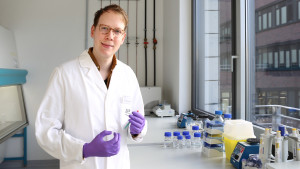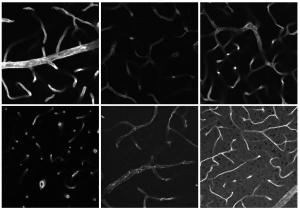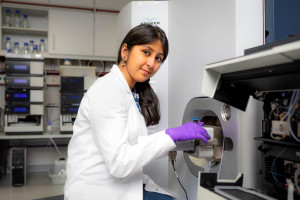Dortmund, 27th February 2024
Dr Christopher Nelke is an assistant physician and research associate at the Clinic for Neurology at Düsseldorf University Hospital (Universitätsklinikum Düsseldorf, UKD). His research interests include neuromuscular diseases such as myasthenia gravis. The medical practitioner participates in the Clinician Scientist programme of Heinrich Heine University Düsseldorf, which is sponsored by the German Research Foundation (Deutsche Forschungsgemeinschaft, DFG). According to the DFG, the focus is on structured training and the scientific qualification of researching physicians. In 2022, Dr Nelke spent two weeks at ISAS as a guest researcher.

During his research stay at ISAS, Dr Christopher Nelke, assistant physician at Düsseldorf University Hospital, spent several days in the laboratory solely preparing samples.
© ISAS
1. During your stay at ISAS, you had thymus samples with you. Why were you analysing them?
Nelke: At UKD, we are addressing myasthenia gravis. This is an autoimmune disease in which antibodies against the connection between nerves and muscles lead to muscle weakness. In all probability, these antibodies are in part formed due to a misdirected immune response against the thymus. The thymus, also known as the thymus gland, is a small lymphatic organ located behind the sternum.
Through my stay at ISAS, we wanted to learn how the protein composition of the thymus changes with this disease. The analysis is not particularly easy, as the material is rare and the thymus is different in every individual. The samples stem from patients with myasthenia gravis. Since the disease is rare, these specific samples are also very rare. For this reason, we had to limit ourselves to certain areas of the gland that were present in all samples. Together with colleagues at ISAS, I analysed them using mass spectrometric proteomics.
2. When you got an insight in Dortmund into the proteomics workflow for mass spectrometric examination, did this include all the steps needed to prepare samples? Of what use was the practical insight for your own research?
Nelke: The insight was very valuable, as up to then we had not seen enough really practical problems for a valid analysis. How big may one sample be? How big may the differences between individual samples be? How many samples can be processed and analysed at once? I believe these insights will help us to better plan upcoming research projects.
3. From your perspective, what is the greatest challenge or the greatest advantage of your work between the patient's bed and the research laboratory?
Nelke: Time is certainly the biggest challenge. It is always a balancing act to meet the demands of patients and simultaneously to find time for research. But I also think it is very helpful to be familiar with patients and their problems in order to follow up issues in research in a targeted manner and to then interpret the results.
(The interview was conducted by Sara Rebein.)








